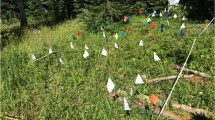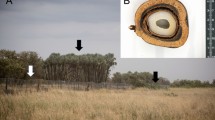Abstract
Resprouting of Echinacea angustifolia Augments Sustainability of Wild Medicinal Plant Populations. Overharvest of wild Echinacea species root has been a significant concern to the herbal industry. Harvesters of wild Echinacea angustifolia showed us that even after harvesting the top 15 to 20 cm of root, some plants resprout. We marked locations of harvested plants at sites in Kansas and Montana and reexamined them two years later to see if they resprouted from remaining root reserves. Approximately 50% of the roots resprouted at both Kansas and Montana sampling sites, despite droughty weather conditions in Montana. The length of root harvested significantly affected the ability of the plant to resprout. Those plants that were more shallowly harvested and had less root length removed were more likely to resprout. These data indicate that echinacea stands can recover over time from intensive harvest if periods of nonharvest occur. Our echinacea harvest study emphasizes that the entire biology of medicinal plants must be considered when evaluating their conservation status.





Similar content being viewed by others
Literature Cited
American Herbal Products Association. 2000. 1999 Tonnage Survey Report. American Herbal Products Association, Silver Spring, Maryland.
________. 2003. Tonnage Survey of North American Wild-Harvested Plants, 2000–2001. American Herbal Products Association, Silver Spring, Maryland.
Binns, S. E., B. R. Baum, and J. T. Arnason. 2002. A Taxonomic Revision of the Genus Echinacea (Heliantheae; Asteraceae). Systematic Botany 27:610–632.
Blumenthal, M. and L. E. Urbatsch. 2006. Echinacea Taxonomy—Is the Re-classification of the Genus Warranted? HerbalGram 72: 30–31, 80.
Cech, R. 2002. Growing At-Risk Medicinal Herbs. Horizon Herbs LLC.
Cochrane, J. F. and P. Delphey. 2002. Status Assessment and Conservation Guidelines. Dakota Skipper, Hesperia Dacotae (Skinner) (Lepidoptera: Hesperiidae), Iowa, Minnesota, North Dakota, South Dakota, Manitoba, and Saskatchewan. Department of the Interior, U.S. Fish and Wildlife Service. April 2002. 77 pp.
Crawford, Glinda 1999. Echinacea, Prairies, and Rural Life on Fire... “Help!” A North Dakota Report. United Plant Savers Newsletter 21:20–22.
Hicks, J. 2002. Personal communication. Patrol office, Ouachita National Forest.
Hurlburt, Dana Price. 1999. Population Ecology and Economic Botany of Echinacea angustifolia, a Native Prairie Medicinal Plant. Ph.D. dissertation, Department of Ecology and Evolutionary Biology. University of Kansas, Lawrence.
Kindscher, K. 1991. Medicinal Plants of the Prairie: An Ethnobotanical Guide. University Press of Kansas, Lawrence.
________. 2006. Conservation Status of Echinacea Species. Report to the U.S. Forest Service. 247 pages.
Klein, R. 2000. Wise Old Plants. Pages 24–38 in Planting the Future: Saving Our Medicinal Herbs. Healing Arts Press (Inner Traditions).
Kolster, M. K. 1998. Impacts of the Global Echinacea Market on the People and Land of the Fort Peck Assiniboin and Sioux Reservation. Master’s thesis, University of Montana, Missoula.
McGregor, R. L. 1968. The Taxonomy of the Genus Echinacea (Compositae). University of Kansas Science Bulletin 484:113–142.
Price, D. M. and K. Kindscher. 2007. One Hundred Years of Echinacea angustifolia Harvest in the Smoky Hills of Kansas, U.S.A. Economic Botany 61:86–95.
Solberg, D. 1999. Uncommon Bounty. High Country News, Vol. 31, No. 3. SPSS 2003. SPSS 12.0 for Windows. Chicago, Illinois.
Stewart, K. 1999. Where Have All the Flowers Gone? Natural Foods Merchandiser (Spring).
Studiner, S. 2002. Personal communication. Custer National Forest Service ranger, July 2002.
Torkelson, K. 1999. Coneflower Poachers Hit Public Lands. U.S. Fish and Wildlife Service, Mountain Prairie Region. News release (June 21).
U.S. Fish and Wildlife Service. 1989. Tennessee Coneflower Recovery Plan. Asheville, North Carolina.
________. 1995. Smooth Coneflower Recovery Plan. Atlanta, Georgia.
Weaver, J. E. and T. J. Fitzpatrick. 1934. The Prairie. Ecological Monographs 4:109–295.
Acknowledgments
We want to thank the echinacea harvesters that we worked with, including Pam and John Luna of Plainville, Kansas, and Terry and Laura Fox at Buck Mountain Ranch, Miles City, Montana. Fieldworkers included Maggie Riggs, Erika Noguera, Hillary Loring, Suneeti Jog, and Quinn Long. Tables and figures, along with edits and comments, by Bernadette Kuhn, Jennifer Delisle, and Debra Baker were invaluable. The manuscript was improved by edits, comments, and insights from Michael McGuffin, Robyn Klein, Hillary Loring, Suneeti Jog, and Joe-Ann McCoy. Funding for this work came from the U.S. Forest Service (Project Number—01-CS-11015600–060) and Terry Fox of Buck Mountain Botanicals.
Author information
Authors and Affiliations
Corresponding author
Rights and permissions
About this article
Cite this article
Kindscher, K., Price, D.M. & Castle, L. Resprouting of Echinacea angustifolia Augments Sustainability of Wild Medicinal Plant Populations. Econ Bot 62, 139–147 (2008). https://doi.org/10.1007/s12231-008-9016-9
Received:
Accepted:
Published:
Issue Date:
DOI: https://doi.org/10.1007/s12231-008-9016-9




